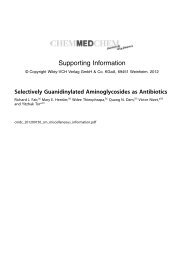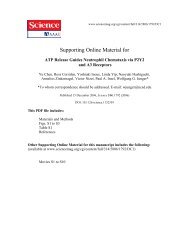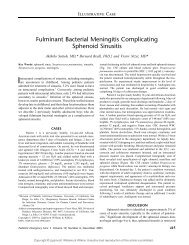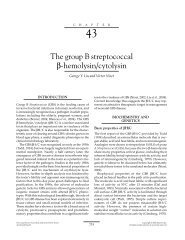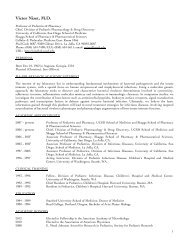BACTERIAL SEPSIS AND MENINGITIS - Nizet Laboratory at UCSD
BACTERIAL SEPSIS AND MENINGITIS - Nizet Laboratory at UCSD
BACTERIAL SEPSIS AND MENINGITIS - Nizet Laboratory at UCSD
You also want an ePaper? Increase the reach of your titles
YUMPU automatically turns print PDFs into web optimized ePapers that Google loves.
A streptococcal infection now is reported infrequently<br />
[37–43], but it can occur rarely in epidemic form in nurseries<br />
[37,44–47]. The reemergence of virulent group A<br />
streptococcal infections during the last 3 decades, including<br />
invasive disease and toxic shock syndrome, has been<br />
reflected in more case reports of severe disease in<br />
pregnant women and newborns.<br />
Group A streptococcal disease in the mother can affect<br />
the fetus or newborn in two clinical p<strong>at</strong>terns. M<strong>at</strong>ernal<br />
streptococcal bacteremia during pregnancy can lead to<br />
in utero infection resulting in fetal loss or stillbirth; altern<strong>at</strong>ively,<br />
acquisition of group A streptococci from the<br />
m<strong>at</strong>ernal genital tract can cause early-onset neon<strong>at</strong>al sepsis<br />
similar to early-onset group B streptococcal disease. In<br />
the first form of disease, previously healthy pregnant<br />
women with influenza-like signs and symptoms have<br />
been reported. This present<strong>at</strong>ion rapidly progressed to<br />
dissemin<strong>at</strong>ed intravascular coagulop<strong>at</strong>hy and shock, with<br />
high mortality and risk to the fetus or newborn [48–50].<br />
The fe<strong>at</strong>ures of 38 cases of neon<strong>at</strong>al invasive group A<br />
streptococcal infection from the liter<strong>at</strong>ure were c<strong>at</strong>alogued<br />
more recently [51]. Overall mortality r<strong>at</strong>e in<br />
neon<strong>at</strong>al invasive group A streptococcal infection was significantly<br />
high (31%). Most of these infants presented<br />
with early-onset infection (62%), with many occurring<br />
in the first 48 hours of life. A specific focus of group A<br />
streptococcal infection was documented in three quarters<br />
of cases—42% of neon<strong>at</strong>es had pneumonia, sometimes<br />
complic<strong>at</strong>ed by empyema, and 17% had a toxic shock<br />
syndrome–like present<strong>at</strong>ion. Among the cases of earlyonset<br />
group A streptococcal infection, puerperal sepsis<br />
or toxic shock syndrome–like sepsis in the mother during<br />
the peripartum period was an associ<strong>at</strong>ed factor in 62% of<br />
cases. In l<strong>at</strong>e-onset cases of neon<strong>at</strong>al group A streptococcal<br />
infection reviewed in this series, soft tissue infections,<br />
meningitis, and pneumonia were among the reported<br />
clinical manifest<strong>at</strong>ions. An earlier review by Greenberg<br />
and colleagues [52] on 15 cases of group A streptococcal<br />
neon<strong>at</strong>al infection yielded similar st<strong>at</strong>istics on clinical present<strong>at</strong>ions<br />
and mortality.<br />
In addition to sepsis, meningitis, and toxin-medi<strong>at</strong>ed<br />
disease in the neon<strong>at</strong>e, focal infections, including cellulitis,<br />
omphalitis, Ludwig angina [53], pneumonia, and osteomyelitis,<br />
have been reported. Because all group A<br />
streptococci are susceptible to b-lactam antibiotics, the<br />
current str<strong>at</strong>egy for prevention or tre<strong>at</strong>ment of infections<br />
caused by GBS also could apply to infections caused by<br />
group A streptococci.<br />
STREPTOCOCCUS PNEUMONIAE<br />
Although pneumococcal infections in the neon<strong>at</strong>e are<br />
unusual occurrences, they are associ<strong>at</strong>ed with substantial<br />
morbidity and mortality [54–61]. Bortolussi and colleagues<br />
[54] reported five infants with pneumococcal sepsis<br />
who had respir<strong>at</strong>ory distress and clinical signs of infection<br />
on the first day of life. Three infants died, two within 12<br />
hours of onset. S. pneumoniae was isol<strong>at</strong>ed from the vaginas<br />
of three of the mothers. Radiographic fe<strong>at</strong>ures were<br />
consistent with hyaline membrane disease or pneumonia<br />
or both. The clinical fe<strong>at</strong>ures were strikingly similar to<br />
fe<strong>at</strong>ures of early-onset group B streptococcal infection,<br />
CHAPTER 6 Bacterial Sepsis and Meningitis<br />
231<br />
including the associ<strong>at</strong>ion of prolonged interval after<br />
rupture of membranes, early-onset respir<strong>at</strong>ory distress,<br />
abnormal chest radiographs, hypotension, leukopenia,<br />
and rapid deterior<strong>at</strong>ion. F<strong>at</strong>al pneumococcal bacteremia<br />
in a mother 4 weeks postpartum and the same disease<br />
and outcome in her healthy term infant, who died <strong>at</strong><br />
6 weeks of age, suggested an absence of protective antibody<br />
in the mother and the infant [55].<br />
Hoffman and colleagues from the United St<strong>at</strong>es Multicenter<br />
Pneumococcal Surveillance Group [59] identified<br />
20 cases of neon<strong>at</strong>al S. pneumoniae sepsis or meningitis<br />
in a review of 4428 episodes of pneumococcal infection <strong>at</strong><br />
eight children’s hospitals from 1993-2001. Ninety percent<br />
of the infants were born <strong>at</strong> term, with a mean age <strong>at</strong> the<br />
onset of infection of 18.1 days. Only two of the mothers<br />
had clinically apparent infections <strong>at</strong> the time of delivery.<br />
Eight neon<strong>at</strong>es had meningitis, and 12 had bacteremia;<br />
4 of the bacteremic neon<strong>at</strong>es also had pneumonia. The<br />
most common infecting pneumococcal serotypes were 19<br />
(32%), 9 (18%), and 18 (11%). Penicillin and ceftriaxone<br />
nonsusceptibility were observed in 21.4% and 3.6% of isol<strong>at</strong>es.<br />
Three de<strong>at</strong>hs (15%) occurred, all within 36 hours of<br />
present<strong>at</strong>ion. A case report of peripartum transmission of<br />
penicillin-resistant S. pneumoniae underlines concern th<strong>at</strong><br />
the increasing use of peripartum ampicillin to prevent<br />
group B streptococcal disease in neon<strong>at</strong>es may result in<br />
an increase in neon<strong>at</strong>al infections caused by b-lactam–<br />
resistant organisms [60].<br />
OTHER STREPTOCOCCI<br />
Human isol<strong>at</strong>es of group C and G streptococci form large<br />
b-hemolytic colonies th<strong>at</strong> closely resemble those of group<br />
A streptococcus and share many virulence genes, including<br />
genes encoding surface M proteins and the cytotoxin<br />
streptolysin S. Group C streptococci have been associ<strong>at</strong>ed<br />
with puerperal sepsis, but neon<strong>at</strong>al sepsis or meningitis<br />
rel<strong>at</strong>ed to these organisms is rare [62–65]. Likewise,<br />
group G streptococci are an infrequent cause of neon<strong>at</strong>al<br />
sepsis and pneumonia [66–70]. M<strong>at</strong>ernal intrapartum<br />
transmission was the likely source for most cases [68],<br />
and concurrent endometritis and bacteremia in the<br />
mother and sepsis in the neon<strong>at</strong>e have been reported<br />
[69]. Dyson and Read [68] found very high r<strong>at</strong>es of coloniz<strong>at</strong>ion<br />
in neon<strong>at</strong>es born <strong>at</strong> New York Hospital in a<br />
1-year survey of discharge cultures in 1979; the monthly<br />
incidence of cultures of group G streptococci from the<br />
nose and umbilicus ranged from 41% to 70%. During<br />
this period, group B streptococcal coloniz<strong>at</strong>ion was only<br />
1% to 11% [68].<br />
Viridans streptococci are a heterogeneous group of<br />
a-hemolytic and nonhemolytic streptococci th<strong>at</strong> are constituents<br />
of the normal flora of the respir<strong>at</strong>ory and gastrointestinal<br />
tracts of infants, children, and adults. There are<br />
several classific<strong>at</strong>ion schem<strong>at</strong>a for these streptococci, and<br />
they may bear different design<strong>at</strong>ions in the liter<strong>at</strong>ure.<br />
Streptococcus bovis is capable of causing neon<strong>at</strong>al sepsis<br />
and meningitis th<strong>at</strong> is clinically similar to sepsis caused<br />
by GBS [71–73]. Rare cases of neon<strong>at</strong>al sepsis caused by<br />
Streptococcus mitis have been reported [74,75].<br />
Viridans streptococci accounted for 23% of isol<strong>at</strong>es<br />
from cultures of blood and CSF obtained from neon<strong>at</strong>es



